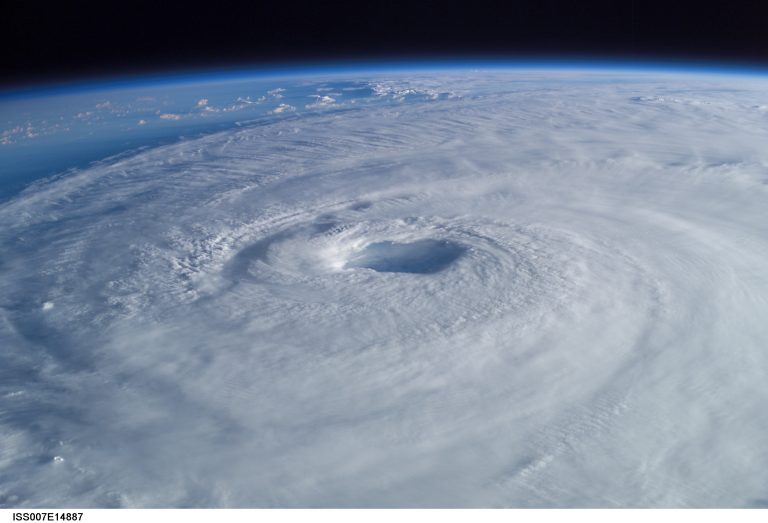Hurricane Alarmists Take Blow As New Study Pours Cold Water On Human Impact
Hurricane Alarmists Take Blow As New Study Pours Cold Water On Human Impact
PIK takes a blow: stronger hurricanes cannot be explained by higher CO2
By Die kalte Sonne
(German text translated/edited by P Gosselin)
Image: NASA (public domain)
Whenever the hurricane season in the Caribbean begins, the whole world and the German Potsdam Institute for Climate Impact Research (PIK) wait for a strong storm, as it presents the ideal opportunity to sell climate change, as was the case in September 2017 when Potsdam’s Neueste Nachrichten (PNN) daily reported with reference to the PIK’s Anders Levermann:
Global warming provides energy for stronger tropical storms
According to Potsdam climate researchers, the impact of the current tropical cyclones can be attributed to climate change. Burning coal, oil and gas increases the temperature of the planet and thus provides energy for ever stronger tropical storms, explained Anders Levermann of the Potsdam Institute for Climate Impact Research (PIK). “Unfortunately, physics here is very clear: hurricanes draw their destructive energy from the warmth of the ocean. The water temperatures in the region are too high. Climate change does not cause these storms, but it can “make their consequences worse.”
Will the intensity of hurricanes increase with climate change? Can this be detected today, as Levermann concludes so trivially? This is not the case, say researchers around Lory Trenary from George Mason University in Fairfax, Virginia. They investigated climate models and re-analyses and found no connection with the drive by greenhouse gases, especially CO2.
The long-term trends 1958-2005 were ultimately contradictory and not valid. An attribution of hurricane intensity to climate change is still not possible. In the introduction to their current work, they also mention Levermann’s argument: “Warmer ocean-more severe storms! After a detailed analysis, however, they come to the following conclusion:
These results indicate that currently we cannot attribute changes in North Atlantic hurricane intensity to human related forcings.”
Already in the past there was disagreement among atmospheric researchers about the influence of anthropogenic forcing on hurricane intensity. Levermann did not bother with this last year either, because as a researcher he is undoubtedly informed about the various topics. So the only reason for spreading the false claim remains the climate siren character of the PIK and others.
Here is the abstract from the work of Trenary et al., which appeared in the Geophysical Research Letters on March 4, 2019:
Are mid‐20th century forced changes in North Atlantic hurricane potential intensity detectable?
Abstract: The impact of anthropogenic forcings on tropical North Atlantic hurricane potential intensity (PI) is evaluated in CMIP5 models for the period 1958‐2005. Eleven models are examined, but only seven models have a forced response that is distinguishable from internal variability. The use of discriminant analysis to optimize detectability does not yield a clear, common climate change signal. Of the seven models with a significant response, one has a negative linear trend while two have a positive linear trend. The trend in PI is not even consistent among reanalyses, although this difference is not statistically significant because of large uncertainties. Furthermore, estimates of PI internal variability have significantly different variances among different reanalysis products. These disagreements between models, reanalysis products, and between models and reanalyses, in conjunction with relatively large uncertainties, highlight the difficulty of detecting and attributing observed changes in North Atlantic hurricane potential intensity.
Plain Language Summary: Observed temperature has been steadily increasing over the last century and much of this warming can be attributed to greenhouse gas emissions. Theoretically, the maximum intensity (or potential intensity) a hurricane can achieve depends strongly upon sea surface temperature, with warmer temperatures producing stronger storms. From this perspective, we might expect that the warming surface temperatures are driving observable changes in hurricane intensity. To this end, we analyze climate model experiments to determine if the observed changes in North Atlantic hurricane intensity can be attributed to human related emissions over the period 1958‐2005. Of the eleven models analyzed, we find that only seven predict that hurricane potential intensity has changed in response to greenhouse gas and aerosol emissions. The change in potential intensity differs across models, with one model predicting a decreasing trend in North Atlantic hurricane potential intensity, while two models predict an increasing trend in potential intensity. Different reanalysis datasets are likewise inconsistent. These results indicate that currently we cannot attribute changes in North Atlantic hurricane intensity to human related forcings. It is possible that as greenhouse gas concentrations continue to increase, an unequivocal forced response in North Atlantic potential intensity may emerge in the future.”



